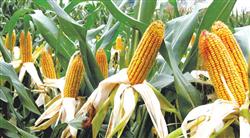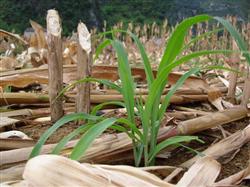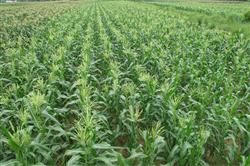How can summer corn be planted with high yield?

How can summer corn be planted with high yield? Please introduce the method of planting summer corn if you want to obtain high yield, you can refer to the following methods: 1. Select seeds: before sowing, spread the corn seeds evenly and sun for 2 days, and then remove small grains, blighted grains, broken grains and mildew grains, which is the basis for cultivating strong seedlings. 2. Single-seed seed: single-grain seed can avoid competing for more fertilizer and injuring roots in inter-seedling, which is beneficial to the cultivation of strong seedlings. If direct seeding, it is appropriate to use 2 kg of seed per 667 square meters, early and fixed seedlings after emergence. 3. The method of keeping seedlings: leave 4000 seedlings every 667m2. ⑴ line spacing is 50 cm, plant spacing is 30 cm, ⑵ line spacing is 60 cm, plant spacing is 25 cm, ⑶ line spacing is 60 cm, plant spacing is 20 cm. 4. skillful application of seed fertilizer: mixed application of 2 kg urea and 2 kg diammonium per 667 square meters. When planting, 1 gram per hole. If you broadcast live, one person will catch the seed and the other will catch the fat. 5. Early application of strong seedling fertilizer: after seedling setting (5-leaf stage) combined with stubble ploughing, loose soil squatting seedlings, topdressing strong seedling fertilizer, applying 50 kg ammonium bicarbonate every 667 square meters. 6. Heavy application of Zhuanggu fertilizer: maize needs the most fertilizer from jointing to booting stage, and nitrogen fertilizer should be re-applied in this period, 20-25 kg urea per 0.07 ha. Fertilizer should be ditched and applied deeply, with a depth of 10 cm and a distance of 12-15 cm from the plant. Grain fertilizer should be applied from heading to flowering, generally 7.5-12.5 kg of urea per 0.07 ha. 7. Watering: maize enters the vigorous growth stage from jointing to heading stage, especially about 10 days before heading, which is the critical period of water demand. At this time, the soil relative water content should be 70-80%. Maize from heading to flowering stage is very sensitive to water, which is the peak of water demand, and the relative water content of soil should reach about 80%. Grain formation to wax ripening stage is an important stage to determine maize yield, and sufficient water is still needed. During this period, the soil relative water content should be 70-75%. In the above stages, if the soil water content is lower than the lower limit of suitable water content, it should be watered. 8. control of diseases and insect pests: in the middle and later stages of maize growth, 1000-1500 times of omethoate EC can be used to control when the average number of aphids per 10 corn plants is more than 500. Corn borer is the main pest at ear stage, 250 grams of 3% phoxim granules mixed with fine sand 5-6 kg per 0.07 ha, sprinkled on corn heart leaves or leaf axils, male ear bracts and ears. To control corn leaf spot, 50% carbendazim or 50% carbendazim 500 times solution can be sprayed every 5 days for 2-3 times. 9. Artificial castration and artificial pollination: when the male ear of maize is just exposed to the top leaf and there is no loose powder, the male ear is removed between rows or plants, so that nutrients can be supplied to the ear centrally. it can also reduce diseases, improve light transmittance, regulate field microclimate and promote early ripening of corn. In order to ensure complete pollination, the unpollinated fresh filaments should be examined plant by plant in the later stage of male ear pollination, and artificial pollination should be carried out for the unpollinated fresh filaments. 10. Appropriate late harvest: appropriate late harvest without affecting the sowing of the next crop. In order to achieve the goal of late harvest and yield increase, the fertilizer and water management of corn in the middle and later stage should keep up with the management of fertilizer and water to ensure that the green leaves of corn are mature. Harvest when the bracts of corn become white, loose, the grain line disappears and the inclusions completely harden. Click to get more corn planting techniques click to get more food crop planting techniques
- Prev

How to control diseases and insect pests by planting summer corn?
How to control diseases and insect pests by planting summer corn? Please introduce the method of summer corn planting can refer to the following methods to control diseases and insect pests: first, seed treatment every 100 kg of seeds with 100 ml of gold + bright ear (or Li Kexiu) 100ml + 170ml of handsome seedlings for seed coating. Can prevent and cure seedling blight,.
- Next

How can large-scale planting of summer corn increase production?
How can large-scale planting of summer corn increase production? Please introduce the method of planting corn to achieve high yield from the following points: (1) select improved varieties according to local conditions. According to the planting purpose and production area, select the approved varieties, the leading varieties issued by the government and the excellent varieties selected from the local official demonstration.
Related
- The first cup of black tea in spring, the flavor and history of tea gardens in Kenya, Africa
- The computer can not only choose potatoes, but also grow tea rice. AI will grow winter oolong tea champion.
- It is not only the inflated tea bitten by insects, but also engraved with the four seasons tea in Beipu.
- The Oriental Beauty Tea Festival in Zhuxian County takes the stage at the weekend to experience the plus-size feast of oil tea.
- & quot; Oriental Beauty Tea & Exploration of Emei in Hsinchu, the hometown of quot;
- The new variety of strawberry "Tainong 1" dessert is the first choice with mellow aroma. Crimson gorgeous
- History of Tea in Taiwan: from Wild Inner Mountain to Export Tea Garden
- Two types of Taiwan Oriental Beauty Black Tea won the British three-Star Award for Childhood Tea Xiang Zhang Jiaqi changed from pilot to champion tea maker.
- Banana species and varieties: the planting history of Taiwan Xianren banana and dwarf banana is long, is banana disease resistant?
- Coffee planting Technology: Qianjie Coffee from Seedling to harvesting

